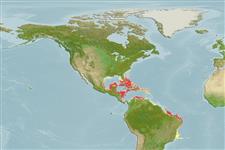Common names from other countries
Environment: milieu / climate zone / depth range / distribution range
Ecología
marino asociado a arrecife; rango de profundidad 10 - 180 m (Ref. 85755), usually 20 - 60 m (Ref. 27115). Tropical; 22°C - 27°C (Ref. 27115)
Western Central Atlantic: West Indies including the Bahamas and Central America.
Tamaño / Peso / Age
Maturity: Lm ? range ? - ? cm
Max length : 10.0 cm TL macho / no sexado; (Ref. 7251)
Espinas dorsales (total) : 13; Radios blandos dorsales (total) : 9.
A solitary species (Ref. 26340) found on nearly vertical cliffs and drop-offs beyond outer reefs. Often upside-down. Retreats into recesses when alarmed (Ref. 9710). Has been reared in captivity (Ref. 35420). Most common in water more than 30 m deep. Gradually replaces G. loreto at depths of 15-30 m (Ref. 26938).
Life cycle and mating behavior
Maturities | Reproducción | Spawnings | Egg(s) | Fecundities | Larva
Robins, C.R. and G.C. Ray, 1986. A field guide to Atlantic coast fishes of North America. Houghton Mifflin Company, Boston, U.S.A. 354 p. (Ref. 7251)
IUCN Red List Status (Ref. 130435)
CITES (Ref. 128078)
Not Evaluated
Threat to humans
Harmless
Human uses
Pesquerías: comercial; Acuario: Comercial
Herramientas
Special reports
Download XML
Fuentes de Internet
Estimates based on models
Preferred temperature (Ref.
115969): 23.6 - 27.9, mean 26.7 (based on 168 cells).
Phylogenetic diversity index (Ref.
82804): PD
50 = 0.5313 [Uniqueness, from 0.5 = low to 2.0 = high].
Bayesian length-weight: a=0.00389 (0.00180 - 0.00842), b=3.12 (2.94 - 3.30), in cm Total Length, based on all LWR estimates for this body shape (Ref.
93245).
Nivel trófico (Ref.
69278): 3.5 ±0.50 se; based on food items.
Fishing Vulnerability (Ref.
59153): Low vulnerability (10 of 100).
